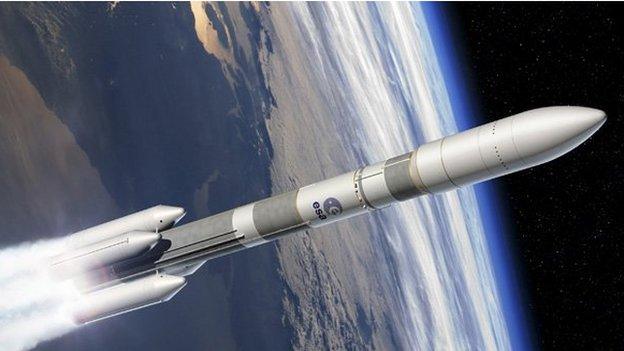SpaceX scrubs rocket recovery launch
- Published

US company SpaceX has postponed an experiment to bring part of its Falcon rocket down to a soft landing on a floating sea platform.
The firm has now rescheduled the Cape Canaveral demonstration for Friday.
Once the first stage of the rocket launches, and has finished its work, it will head back to Earth to try to touch down on a sea barge in the Atlantic.
If this kind of capability can be proven, it promises dramatically lower launch costs in the future.
All segments of a rocket are usually discarded after use and are destroyed as they fall back down.
SpaceX, however, has been practising the controlled return of the first stage of its Falcon 9 vehicle.
The problem responsible for Tuesday's scrub decision related to a technical issue detected in the steering mechanism of the rocket's upper stage.
The next chance to send up the vehicle will be on Friday at 10:09 GMT (05:09 local Florida time).
SpaceX itself has been playing down expectations, rating the chances of success at no more than 50-50.

"I'm pretty sure this will be very exciting, but, as I said, it's an experiment," cautioned Hans Koenigsmann, vice president for mission assurance at SpaceX.
"There's a certain likelihood that this will not work out all right, that something will go wrong. It's the first time we have tried this - nobody has ever tried it as far as we know."
The primary purpose of the flight is to send the Dragon cargo ship on a path to rendezvous with the International Space Station (ISS).
It will be the first American re-supply mission to the orbiting platform since October's spectacular explosion of a freighter system operated by competitor Orbital Sciences Corporation.
But it is the outcome of the SpaceX experiment that is likely to make the headlines.
The firm believes it can return, refurbish and re-use key elements of its rockets.
To this end, it has been testing first-stage boosters that relight their engines to try to slow their fall through the atmosphere, attaching fins to help guide them downwards, and legs to make a stable touchdown.
So far, there have only been mock landings, in which the stage is brought to a hovering position at the surface of the ocean, where, without a solid platform to set down, every booster has subsequently been lost in the water.
Friday's effort will be different in that SpaceX has sent a floating barge to the targeted return site some 300km northeast of Cape Canaveral, Florida.
- Published3 December 2014

- Published29 October 2014

- Published16 September 2014

- Published25 April 2014